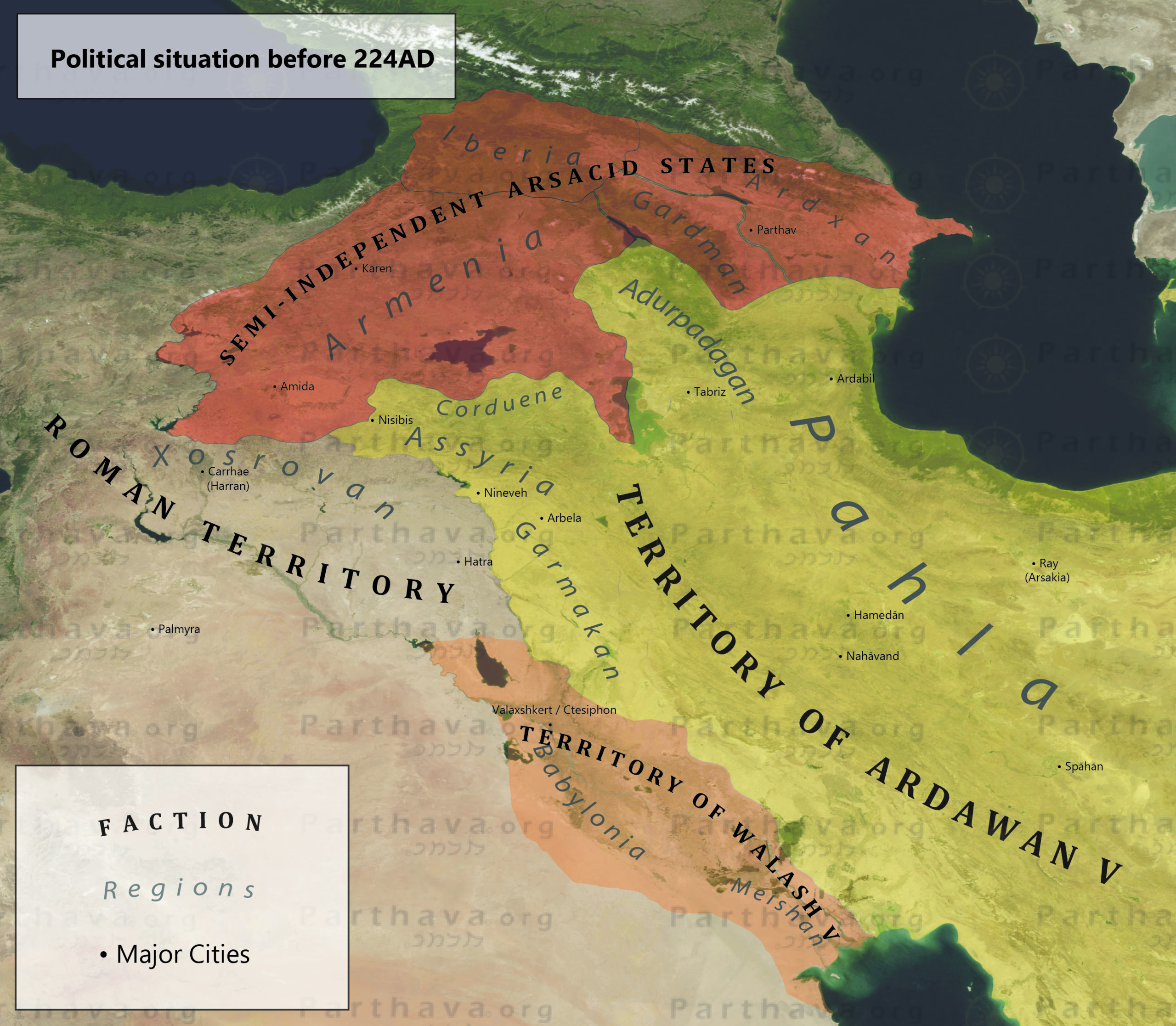The end of the Arsacids marked the rise of the Parthian noble houses and a new Eranian dynasty from the South.
A Narrative by Varan.
Initial situation
In the 20s of the 3rd century, the Arsacid Empire was divided between two brothers. Under the control of Walash V were Babylonia and Maishan in the west, while in Old Parthia, Pahla, Adirpadegan, Persia, the rest of Mesopotamia, as well as Assyria and Khuzestan, Ardawan IV ruled.
At the same time, the Arsacid bloodline had established and secured itself in four other countries:
- Arsacid-Iberia (Georgia) (under Vache)
- Ardxan
- Gardman
- Arsacd-Armenia (under Xusrew II)
Thus, the Arsacid sphere of influence was divided into several factions. Then, in the favor of the hour, a new figure named Ardashir I appeared in the south and rebelled against the Arsacid Empire. After capturing Darabgerd and Eshtakhr – cities in the Parsig region – Ardashir attacked Kerman and installed his son as governor there. The initial phase of Ardashir I is marked by military and political support of the Indo-Parthians from the House of Gundofar, as well as their superior Great House of Pahlav Suran. In 224 AD the Battle of Hormuzgan takes place, where Ardawan IV is killed by Ardashir I. Two years after that, Ardashir attacks Parthian Mesopotamia, defeats and kills Walash V (Sarkhosh Curtis: 76). With these two significant battles, the end of the Parthian-Arsacid empire is sealed.

Fig. 1: Political situation and territories before the coup of Ardashir.
However, there were other Arsacid territories that remained unconquered until that time. These included Arsacid Armenia, Atropatene, i.e. two Arsacid Parthian bastions, as well as the city of Hatra. The attempts of the Persian Ardashir to capture these territories were unsuccessful. Likewise, other circumstances hampered Ardashir’s rise. In Kerman, the people resisted the new Sasanian rulers due to close ties of the former Arsacid ruler Ardawan II to Kerman (Tac. Ann. 6.36.4).
The Early Role of the Parthian Houses
It was not least due to the support of Parthian houses that the Arsacid empire could be taken over by Ardashir I and kept relatively stable. The Armenian historian Moses Khorenatsi testifies regarding the coup (Olbrycht 2012: 30):
After Artashir, son of Sāsān, had killed Artavan and gained the throne, two branches of the Pahlav family called Aspahapet and Surēn Pahlav were jealous that their own kinsman Artashes should rule, and willingly accepted the rule of Artashir, son of Sāsān.
In addition to the Spahbudan and Suran, figures such as Piroz Karen and Gag Karen, members of the House of Karen, are also mentioned as having sided with Ardashir. However, the Karen tribe is described by Khorenatsi as basically anti-Sasanid.
Likewise, the Parthian Xusrew, Shah of Arsacid Armenia, is mentioned by Khorenatsi, according to which he was upset that his relatives, i.e. Parthian families, opposed the Arsacids and paid homage to Ardashir. During the battles of the Arsakids against Ardashir, Xusrew even sent messengers to the eastern territories of the former Parthian Empire to assist in the fight “against the Persians”. But there he met the Suran and Ispahbudan families, who refused Xusrew’s offer (Sarkhosh Curtis: 81). During these notifications, Xusrew also learned that a Karenid named Vehsaxan refused to submit to Ardashir I and therefore he and his family members had been killed on Ardashir’s orders (ibid.).
List of References
Sarkhosh Curtis, Vesta. 2012. The Parthian and Early Sasanian Empires: Adaptation and Expansion, British Institute of Persian Studies (BIPS), Oxbow books, Oxford & Philadelphia.
Tacitus, Annals. The Annals, URL: https://penelope.uchicago.edu/Thayer/E/Roman/Texts/Tacitus/Annals/6B*.html, retrieved February 14th, 2023.
Olbrycht, Marek Jan. 2012. Dynastic Connections in the Arsacid Empire and the Origins of the House of Sāsān, in The Parthian and Early Sasanian Empires: Adaptation and Expansion (edited by Sarkhosh Curtis, Vesta, Pendleton, Elizabeth J., Alram, Michael, Daryaee, Touraj), British Institute of Persian Studies (BIPS), Oxbow books, Oxford & Philadelphia.


